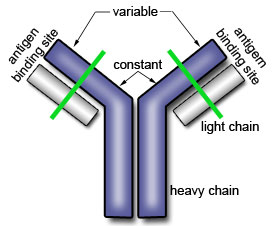Immuno-informatics
Types of Antibody
Antibody : Resources
Techniques and Protocols
Important Links
Antibody Basics
Antibody: An immunoglobulin, a specialized immune protein, produced because of the introduction of an antigen into the body, and which possesses the remarkable ability to combine with the very antigen that triggered its production.
The production of antibodies is a major function of the immune system and is carried out by a type of white blood cell called a B cell (B lymphocyte). Antibodies can be triggered by and directed at foreign proteins, microorganisms, or toxins. Some antibodies are autoantibodies and home in against our own tissues.
Details on Antibody Basics
The term "antibody" dates to 1901. Prior to that time, an "antibody" referred to any of a host of different substances that served as "bodies" (foot soldiers) in the fight against infection and its ill effects.
Structure of antibody
Each antibody consists of four polypeptides- two identical heavy chains and two identical light chains joined to form a "Y" shaped molecule. The amino acid sequence in the tips of the "Y" varies greatly among different antibodies. This variable region, composed of 110-130 amino acids, give the antibody its specificity for binding antigen. The variable region includes the ends of the light and heavy chains. Treating the antibody with a protease can cleave this region, producing Fab or fragment antigen binding that include the variable ends of an antibody. Structure of antibody
Structure of antibodyDifferent kinds of antibodies
There are five diiferent isotypes of antibody depending on their difference in heavy chain. These includes:IgG: Heavy chain γ
This is the principle antibody found in blood and body fluids. Around 75% of the antibody circulating in the blood is IgG, and it is this isotype which provides the majority of the antibody-mediated protection against infection.IgG is rarely produced during an initial response to a given pathogen: this antibody is not produced until around one month initial B cell activation. The principle function of IgG is to bind to pathogens via an antigen-specific receptor, and form antigen-antibody complexes. The formation of these complexes targets the pathogen for destruction via other immune cells.
IgM: Heavy chian μ
The IgM isotype is expressed on the surface of B cells, but it is also secreted by cells. IgM is typically involved early in an immune response, before B cells have had time to begin secreting large quantities of IgG. This isotype can also trigger the complement cascade, via the same pathway as IgG. However, IgM is a more efficient complement trigger: a single IgM-antigen complex can trigger the cascade, whereas multiple IgG-antigen complexes are required.IgA: Heavy chain α
gA is involved in mucosal immunity, preventing colonization by bacteria in areas which are otherwise unprotected from pathogenic attack. This antibody is found in mucosal areasIn addition IgA is secreted in tears, saliva, and breast milk. In breast milk, IgA provides nursing infants with passive immunity against pathogens the mother has encountered (as opposed to the active immunity the infant will acquire when its own immune system is activated).
IgE: Heavy chain ε
This isotype plays an important role in immune responses to certain parasites, in particular parasitic worms.IgE is also strongly associated with allergic reactions, due to its ability to trigger granulocytes to release their toxic chemicals when the antibody comes into contact with its specific antigen. These antigens are proteins from the animal and plant species which commonly trigger allergies.